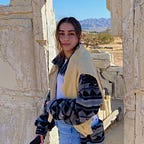COVID & Community Erasure
Travel bans, hate crimes and stereotyping by law enforcement, the Arab-American experience is not equivalent to that of somebody with European origins. Identifying these individual experiences as equal is the reason why Arab-Americans see limited media coverage of and support for their community, especially during COVID-19.
Based upon census data and the lack of coverage about Sherman Oaks and the Arab-American community, generally and throughout the pandemic, the community engagement report I produce will focus on the Arab population’s experience of COVID-19 as residents of Sherman Oaks.
Similar to “COVID-19: Older people’s stories” by Help Age International, I want to give individuals who are part of communities that receive limited media attention the ability to share their story and explain how their community has/has not been supported throughout the pandemic.
According to data by Census Reporter, the majority population in Sherman Oaks is White, at 69%. Moreover, 25% of the 25,000 individuals who live in Sherman Oaks are considered “foreign-born”. Of the foreign-born population, 42% are from Asia. This data makes me wonder whether a percentage of the population that is considered White is of European origins or Southwest Asian and North African descent.
Furthermore, I think it is important to note that of the 25,000 individuals living in Sherman Oaks, 20% of children and 15% of adults speak Indo-European languages. Considering languages spoken in the “Middle East” are categorized as Indo-European, this data leads me to believe that there is a large population of Arabs living in Sherman Oaks that is not being represented in the data or media.
If we were simply looking at the data provided by Census Reporter, Sherman Oaks would appear to be a predominantly White community; however, spend a day in the city and you would come to realize that Sherman Oaks is more culturally rich than the data leads us to believe.
The lack of representation in the demographics data bleeds into data regarding COVID-19. Because we are unsure of how much of the White population inhabiting Sherman Oaks is actually White, we are also unable to identify COVID-19 infection, transmission, and vaccination rates amongst the Arab population within the city.
As a result, it is important to ask the following questions:
Where do you receive information regarding COVID-19?
Do you know someone who has had/passed away from COVID-19?
How has COVID-19 affected your life? Please recount the past year from your perspective.
Has your community received adequate (government) support throughout the pandemic? Prior to the pandemic?
Has your community received adequate media coverage throughout the pandemic? Prior to the pandemic?
Do you feel as though community leaders are doing a sufficient job of protecting you and minimizing your risk? Please expand on a past experience that contributed to your response.
It is also necessary to ask questions regarding demographics, such as the individual’s birthplace and how they racially identify. This information will allow for a comprehensive view of the population being covered and help us gain an understanding of how Arab-Americans, both individually and as a community, have experienced COVID-19.
From the initial interview I conducted with my uncle, Gaby, and after listening to other people’s accounts of the past year, it has become clear that different communities have distinctly inconsistent versions of the pandemic. This is incredibly important and brings attention to the disproportionate effects of COVID-19 on ethnic communities across the state and the country.
Similar to “Race in LA: How does your race and/or ethnicity shape your life and experiences?” by the LAist, I want people to directly share their story with the audience. However, instead of using essays and images, I will tell the story through audio recordings, photographs, and an interactive map. Using Google My Maps, I will create an interactive map and pin a location of significance rather than their address, for safety purposes, for each individual interviewed. Attached to each pin will be the interviewee’s name, an image that relates to the story being told, and a verite style audio recording. This will give a community that does not receive media attention the ability to share their experience of COVID-19.
